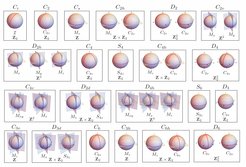Symmetry Indicators and Anomalous Surface States of Topological Crystalline Insulators
Topological materials have been the subject of intense research interest in the past two decades due to their exotic phenomenology and their immense potential in applications. In particular, topological materials exhibit very unusual conductive behavior wherein their surfaces are metallic while their bulk is insulating. In the case of a conventional topological insulator or a quantum Hall system, the surface states responsible for surface conduction exist on all surfaces. However, for the class of materials known as topological crystalline insulators, protected by crystalline symmetries, the situation is a lot more complex and a variety of surface states may be observed depending on the surface and the protecting symmetry. This variety was not captured by any unified theoretical framework until now due to the sheer amount of possible spatial symmetries and surface terminations (there are 230 3D space groups for non-magnetic materials).

In a recent work by a team of researchers from the Max Planck institute for Solid State Research (Eslam Khalaf), Harvard University (Hoi Chun Po and Ashvin Vishwanath), and Tokyo University (Haruki Watanabe), such a unified theoretical framework was found. By being able to incorporate the spatial symmetries in the analysis of the surface Dirac equation on a systematic level, this team was able to obtain a unified approach to understanding all types of possible surface states. The simplicity of the approach enabled an exhaustive classification for all types of TCI surface states in the 230 3D space groups, assuming significant spin-orbit coupling and time-reversal symmetry. In addition, building on the results of previous works, this work has provided an explicit way to predict the possible surface states of a given material based on the symmetry representations in momentum space, which will be invaluable in searching for physical realizations in materials.











